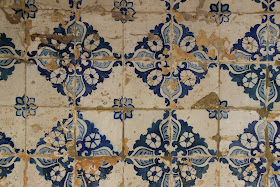But it helps to learn the basics of a complicated lexicon: will your choice be a bica (rich, dark espresso in tiny cup) (or even a dupla-bica for those not faint of heart), carioca (weaker version) pingado (espresso with a few drops of milk), café cheio (espresso with a little extra hot water), garoto (half espresso grounds, half hot milk), galão (equal portions of coffee to milk, served in a glass), and would you prefer escuro or claro?
Ever since Portugal's colonies turned out to be some of the finest coffee-producing regions of the world, café (coffee) and café life have been ingrained in Portuguese culture. From the 18th century when downtown Lisbon was rebuilt after a devastating earthquake, cafés became meeting places for artists, intellectuals, politicians. It's impossible today to walk down a street without coming across a handful at least.
One of Lisbon's best known cafés is A Brasileira (above) in downtown Chiado, right here in the Largo do Chiado ...
The interior of A Brasileira is all old-style grandeur - oak-panelling, mirrored walls and chandeliers ...
... and out on the sidewalk poet Fernando Pessoa who used to hang out here with other literary types, now sits here for eternity, immortalized in this bronze statue, an empty chair thoughtfully next to him, so that anyone can join him for a chat ...
No surprise then to find that bookshops are also seemingly on every corner in this part of town ...
Livraria Bertrand, Rua Garrett, outdoor stallsLivraria Camões, Rua da Misericórdia.
... while at one of my favourite shops around here, A Vida Portuguesa, it's all about retro chic - iconic Portuguese products to evoke nostalgia in a gorgeous converted stone warehouse ...
On summers' nights the area hums with life ...
I watched one night as people start dancing spontaneously in the street, unable to keep still to the sounds of these musicians (from Angola, Cape Verde, São Tomé?) ...
Even Fernando P. seemed to be getting into the spirit of things ...
... and on another, I followed the sounds of a piano to this square where an open-air stage had been set up for a performance of dance and music ...
You've got to love a city where poetry speaks around unexpected corners ...
A wall in Alfama (above) with verse from Pablo Neruda (La Cancion Desesperada): 'Cemetery of kisses, there is still fire in your tombs, still the grapes burn, pecked at by birds.' Below, a bench in Calçada de São Francisco with inscription 'We are the place that we need'.
I have withdrawal pains as my time here draws to an end ... I'm leaving with too many




















































